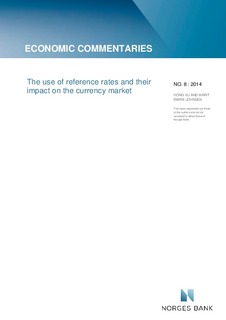| dc.contributor.author | Xu, Hong | |
| dc.contributor.author | Øwre-Johnsen, Marit | |
| dc.date.accessioned | 2018-08-15T08:31:15Z | |
| dc.date.available | 2018-08-15T08:31:15Z | |
| dc.date.issued | 2014 | |
| dc.identifier.uri | http://hdl.handle.net/11250/2558085 | |
| dc.description.abstract | Millions of trades are executed in the currency market daily. Exchange rates move continuously during the day and can fluctuate considerably within a very short time span. In many contexts, there is a need for a daily reference rate that reflects prices at a specific time of day. This is often referred to as a currency fix. In this paper, we look more closely at what a currency fix is and present the most important fixes in the Norwegian krone (NOK) market. We also look at what currency fixes are used for, and how activity, prices and liquidity in various currency crosses are affected around the time the fix rates are set. The main focus of this paper is on NOK. | nb_NO |
| dc.language.iso | eng | nb_NO |
| dc.publisher | Norges Bank | nb_NO |
| dc.relation.ispartofseries | Economic Commentaries;8/2014 | |
| dc.rights | Attribution-NonCommercial-NoDerivatives 4.0 Internasjonal | * |
| dc.rights.uri | http://creativecommons.org/licenses/by-nc-nd/4.0/deed.no | * |
| dc.title | The Use of Reference Rates and Their Impact on the Currency Market | nb_NO |
| dc.type | Others | nb_NO |
| dc.description.version | publishedVersion | nb_NO |
| dc.subject.nsi | VDP::Samfunnsvitenskap: 200::Økonomi: 210::Samfunnsøkonomi: 212 | nb_NO |
| dc.source.pagenumber | 9 | nb_NO |

